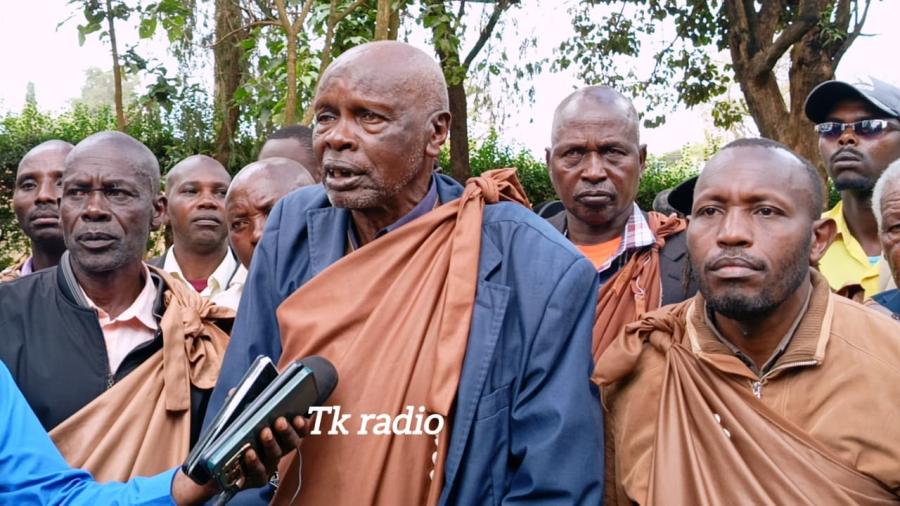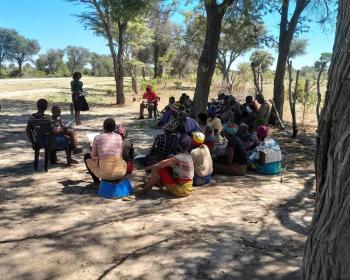The Ju/Wasi people of Bushmanland need help and support to keep their land and develop a better way of life for themselves and their children.
Picture a people…
* who have lost 70 % of the land they had occupied for at least 1,000 and perhaps as long as 23,000 years…
* who were the last independent, self-sufficient hunters and gatherers in Southern Africa - still practicing their ancient way of life only 20 years ago…
* who now crowd apathetically into settlements clustered around an administrative center, where few have work and many are dependent on government welfare…
* who are riddled with tuberculosis and other diseases that they cannot resist because of their deficient diet - composed mainly of cornmeal, alcohol, and sugar…
* whose death rate often exceeds its birth rate…
* whose social structure has disintegrated because the livelihood of many consists of begging from the few who are employed by the administration or the military…
* who have not been offered the training and support necessary to develop a new way of life to replace hunting and gathering…
* who, in spite of this neglect, have made a positive start toward subsistence husbandry - only to live under the threat of a government plan to make the rest of their land into a nature preserve…
Picture all this, and you will have begun to picture the Ju/Wasi of the Nyae Nyae region of Namibia.
They call themselves "the well-mannered people," but today their lives are marred by misery and violence. Crowded together in settlements around the administrative town of Tshumkwe, they lead idle, debilitated lives where drunkenness unleashes jealousies and hatreds that arise from being thrust unprepared into a cash economy - where only a few can get work.
In concentrated, sedentary populations, hunting and gathering are impossible. Thus, today the diet of the Ju/Wasi at Tshumkwe is mostly composed of cornmeal and beer - nearly all of which is provided by welfare or purchased with cash trickling down from the few who have jobs with the government or serve in the military. Many children often eat little more than sugar and water.
This deficient diet underlies a staggering death rate. In 1981, the 920 Ju/Wasi living at Tshumkwe experience 30 births and 31 deaths. The deaths included nine of the 12 babies born in government housing projects that year.
Increasingly, young Ju/Wasi men are being recruited into the army to fight against SWAPO (the Southwest Africa People's Organization). Through his paycheck, every Ju/Wa soldier binds a group of relatives more tightly to the cash economy. And every Ju/Wa recruit means another able-bodied young person is no longer available to work for the self-sufficiency of his people.
If this process continues, the Ju/Wasi may not survive.
Is there an alternative for the Ju/Wasi?
Since 1970, the Ju/Wasi have been confined to Bushmanland, created from a small portion of their ancient territory, the Nyae Nyae region. The government gave the parts of the region containing most of the water and resources to other ethnic groups - the Herero and the Kavango. The Ju/Wasi were left with only the central portion of Nyae Nyae, much of which is uninhabitable and unsuitable for either agriculture or husbandry.
Despite these problems, three groups of Ju/Wasi in eastern Bushmanland have established small cattle posts at their traditional waterholes, away from Tshumkwe. There, they are beginning to support themselves on a mixed economy, as other groups do in Namibia.
At the cattle posts, 200 Ju/Wasi, keeping a total of 184 cattle, now derive a substantial portion of their diet from the products of cattle husbandry: milk, butter, and occasionally beef. In addition, the groups are small enough to supplement their diet by gathering and by hunting small game.
The health of the people living at the cattle posts has improved, their productivity has risen, and their social life is becoming more stable.
Because the people at the cattle posts are practicing a subsistence economy, they do not pose a threat to the fragile ecology of eastern Bushmanland. The cattle herds are small, and kraals are used to protect them at night. This eliminates the temptation to kill predators and thus minimizes the impact of the cattle posts on local wildlife.
Subsistence based on cattle husbandry and, eventually, small-scale gardening, could be the beginning of a more stable, self-sufficient future for the Ju/Wasi - a future very different from the downward spiral of misery, disease, and dependency they now face.
All other Bushman peoples in Namibia/South West Africa have been entirely, dispossessed. If the Ju/Wasi in eastern Bushmanland succeed in their efforts toward self-development and self-sufficiency, they will set an example and represent a new hope for other Bushman peoples.
But this brighter future is threatened…
The department of Nature Conservation in Namibia/South West Africa has proclaimed eastern Bushmanland a nature preserve. In this preserve, the Ju/Wasi would be prohibited from possessing domestic animals or planting crops. Eastern Bushmanland would be developed for tourism. This move would end all hope of achieving self-sufficiency through husbandry - and it would create only eight new jobs for the more than 2,000 Ju/Wasi in Bushmanland.
It is claimed that the Ju/Wasi living in the nature preserve would be encouraged to return to hunting and gathering - despite the fact that they now have scarcely one-fourth the land needed to support themselves by these activities, despite the fact that most Ju/Wasi no longer possess the skills and knowledge needed for successful hunting and gathering.
Many consider the plan to turn Bushmanland into a nature preserve to be nothing short of a blueprint for the extinction of the Ju/Wasi people.
Article copyright Cultural Survival, Inc.


